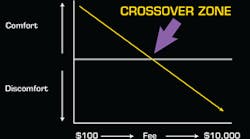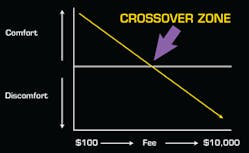By Paul Homoly, DDS
Imagine the type of dentistry that you most love doing. It could be cosmetic implants, reconstructive, orthodontics, or operative. Now, estimate what a typical total treatment fee for that type of dentistry would be, including your fee and any fees required by specialists who would be involved with the case. In the space below, write that number down.
Now that you've got the number written down, let me share with you a principle I call the "Crossover Zone."
On this graph, the horizontal aspect shows dental fees from $100 to $10,000. The vertical column is divided in half. The top half indicates the dentist or the team member's confidence when quoting the fee. The bottom half represents discomfort when quoting the fee. This, the crossover zone, is the level of fee at which the person who is quoting it begins to exhibit discomfort. Here, the dentist is comfortable quoting a fee up to about $3,000, but at $4,000, his knees shake. At $6,000, he avoids eye contact. At $10,000, he may even run from the building.
Crossover numbers vary from person to person based on his or her history, family wealth, and current economic conditions. When fees exceed the crossover point, patients can see hesitation and discomfort in your body language, facial expressions, and voice.
Think about your own crossover number and write it in the space below.
Take a look at the two numbers you've written down -- the first is the fee associated with the type of dentistry you love to do, and the second number is your crossover number. Nearly 90% of the time, a dentist's first number is greater than the second, which means the dentistry you love to do creates anxiety when you quote the fee.
Increase case acceptance by increasing your crossover number
You cannot eliminate your crossover number, but you can increase it. One way is by having patient financing, such as CareCredit, available. Let's say the patient's fee is $5,000. When you quote that fee, wouldn't you be more comfortable also telling your patients that monthly payments are an option? Most dentists and team members are more comfortable including a monthly payment when quoting a large sum.
You can also increase your crossover number by rehearsing the financial conversation. Take time to rehearse your case presentation with another team member. Practice how you will respond when patients ask, "How much will this cost?" Then with confidence, making good eye contact and a pleasant facial expression, quote the entire patient fee. "Mrs. Smith, your fee is $8,000. Many of our patients prefer to pay for their dentistry over time. If that interests you, we accept CareCredit, a health-care credit card with special financing options.* Or, since your care will be provided over the next 30 days, we accept one-third of the total treatment fee when we begin, one-third in the middle, and one-third when we've completed care. Which option would work for you?" As you become more comfortable quoting higher fees, your crossover number will naturally increase.
The right team member for financial conversations
It's important the person talking with patients has a high crossover zone. To identify which team members are best suited to be involved in the financial conversation, sit down with your team and:
- Let them know the typical fee for the type of dentistry you want to do (your first number).
- Share the chart and explain the concept of the crossover zone.
- Have each team member write down his or her own crossover number -- in less than 10 seconds. Typically the team's first thought is the right thought.
Team members with high crossover numbers should be the ones talking with patients about the cost of care.
With a little introspection, practice, and additional financial solutions, your team can work together to increase crossover numbers so you can help more patients access care, do the type of dentistry you like to do, and make discussing fees comfortable for both your team and patients.
*Subject to credit approval. Minimum monthly payments required. See www.carecredit.com for details.
Dr. Paul Homoly, DDS, CSP, is president of Homoly Communications Institute and a world-class leader in dental education. As a comprehensive restorative dentist and educator for more than 30 years, Dr. Homoly speaks with the voice of experience. You may contact him by email at [email protected].
Past DE Issues







